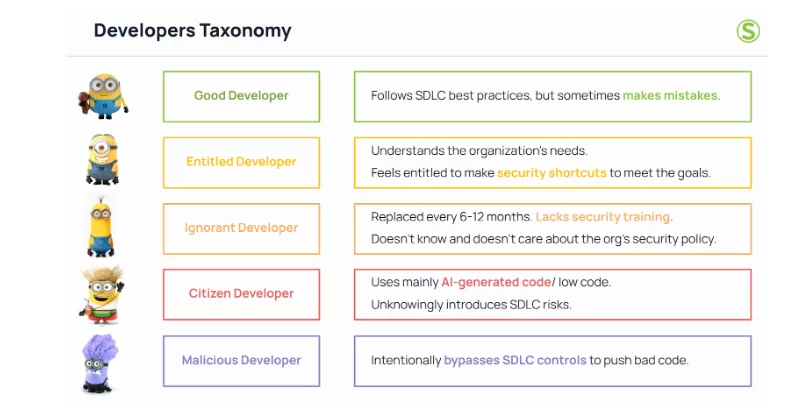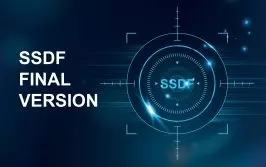In today’s software development landscape, the diversity of developer profiles is both a strength and a vulnerability. The attached taxonomy—ranging from well-intentioned but imperfect “Good Developers” to “Citizen Developers” using AI-generated code, and even “Malicious Developers”—highlights how varying levels of experience, intent, and behavior can pose significant software development lifecycle (SDLC) risks.
Scribe Security addresses these challenges head-on through its policy-as-code guardrails—automated, customizable controls embedded directly into DevOps pipelines. These guardrails continuously enforce secure software supply chain (SSC) practices, regardless of who or what introduces code into the pipeline.
Let’s explore how Scribe helps curb SDLC risks across each developer type:
🟩 Good Developers
Risk Profile: Follows SDLC best practices but can make honest mistakes.
Key Challenge: Human error remains a leading cause of software vulnerabilities.
How Scribe Helps:
Scribe’s automated attestation generation and real-time compliance checks serve as a safety net. Every commit, build, or artifact is verified against organizational security policies. If a mistake slips through—such as a missing signature or an outdated dependency—Scribe detects and blocks the issue before it progresses.
✅ Result: Good developers remain productive without being slowed down, while guardrails quietly catch unintentional errors.
🟨 Entitled Developers
Risk Profile: Understands business needs but takes shortcuts under pressure.
Key Challenge: Security is deprioritized in favor of delivery speed.
How Scribe Helps:
Scribe enforces mandatory security checkpoints that cannot be bypassed. Developers can’t push code into production if it violates established SDLC policies, such as missing SBOMs, unsigned builds, or skipped vulnerability scans. This deters intentional shortcuts by making security non-optional.
✅ Result: Even when corners are attempted, the guardrails ensure the minimum viable security standard is met.
🟧 Ignorant Developers
Risk Profile: Lack security knowledge and training; may not even know policies exist.
Key Challenge: Inadvertently introduce risks due to lack of awareness.
How Scribe Helps:
Scribe abstracts away complexity by codifying policies into automated gates. Developers don’t need to memorize security policies—Scribe enforces them. Through clear feedback and documentation tied to failed checks, Scribe also helps educate developers on what went wrong and how to fix it.
✅ Result: Ignorant developers are guided into secure practices through enforced, contextualized feedback.
🟥 Citizen Developers
Risk Profile: Use AI-generated or low-code tools, unknowingly introducing SDLC risks.
Key Challenge: Speed and abstraction make it easy to skip crucial security checks.
How Scribe Helps:
Scribe provides real-time risk analysis and enforcement tailored to AI-generated components. Every code change—no matter how it was authored—is scanned for compliance, verified for integrity, and traced through cryptographically signed attestations. Additionally, SBOMs are auto-generated, providing full visibility into the source and trustworthiness of AI-generated code.
✅ Result: Scribe turns invisible risks from AI-assisted coding into manageable, observable, and enforceable events—without slowing innovation.
🟪 Malicious Developers
Risk Profile: Intentionally bypass security to introduce harmful or backdoored code.
Key Challenge: Traditional detection may fail without stringent integrity checks.
How Scribe Helps:
First, Scribe helps harden your CI/CD pipelines continuously by alerting you to security gaps and misconfigurations. Second, Scribe enforces a zero-trust model through policy-as-code and cryptographic verification. Every software artifact is validated for provenance, code integrity, and tamper-evidence. Third, malicious attempts to alter code or bypass pipelines are detected instantly and blocked from progressing further.
✅ Result: No matter the intent, malicious actors can’t move unauthorized changes into production thanks to immutable, verifiable SDLC checkpoints.
A Unified Security Model for All Developer Types
Scribe Security’s policy-as-code guardrails provide a consistent, automated way to handle developer diversity—whether it’s based on skill, behavior, or the tools they use (like AI). This approach benefits everyone:
- Security teams can enforce controls without becoming bottlenecks.
- Developers are empowered to move fast with guardrails guiding them toward secure practices.
Organizations gain confidence that no code—regardless of its source—will reach production unless it meets their SDLC standards.

Conclusion
In an age where software is written by humans, AI, and everything in between, organizations must rethink how they secure their SDLC. Scribe Security’s policy-as-code guardrails offer a future-proof solution—ensuring that every developer, regardless of intent or expertise, operates within a framework of enforceable security standards.
With Scribe, security becomes an integral part of software creation—not a separate process, but a built-in safety mechanism that scales with your team and your codebase.
This content is brought to you by Scribe Security, a leading end-to-end software supply chain security solution provider – delivering state-of-the-art security to code artifacts and code development and delivery processes throughout the software supply chains. Learn more.



